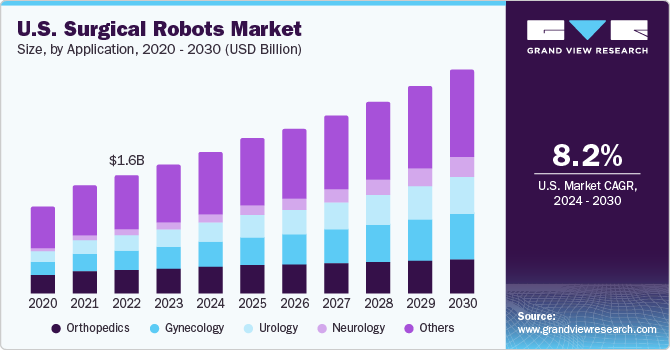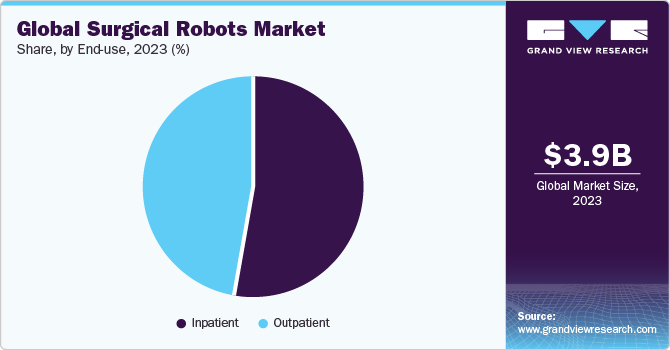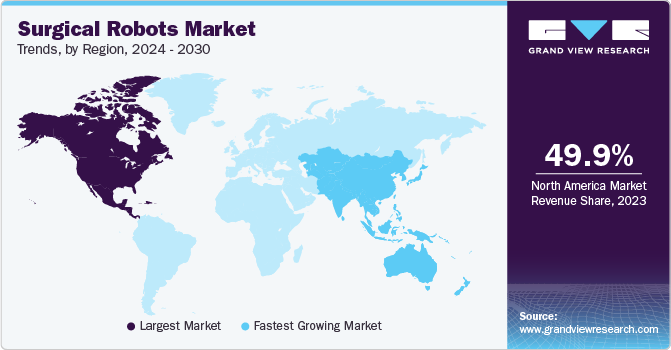- Home
- »
- Medical Devices
- »
-
Surgical Robots Market Size, Share & Growth Report, 2030GVR Report cover
![Surgical Robots Market Size, Share & Trends Report]()
Surgical Robots Market Size, Share & Trends Analysis Report By Application (Neurology, Urology, Orthopedics, Gynecology), By End-use (Inpatient, Outpatient), By Region, And Segment Forecasts, 2024 - 2030
- Report ID: 978-1-68038-811-4
- Number of Report Pages: 118
- Format: PDF, Horizon Databook
- Historical Range: 2018 - 2022
- Forecast Period: 2024 - 2030
- Industry: Healthcare
Surgical Robots Market Size & Trends
The global surgical robots market size was estimated at USD 3.92 billion in 2023 and is expected to grow at a compound annual growth rate (CAGR) of 9.5% from 2024 to 2030. Shortage of physicians and surgeons across the globe and increasing adoption of automated instruments used for surgery are major factors driving market growth. Furthermore, growing prevalence of bone degenerative diseases and rising number of hip & knee replacement surgeries due to increasing cases of arthritis & osteoporosis are anticipated to drive growth. For instance, according to the Agency for Healthcare Research and Quality report, over 4,50,000 hip replacement surgeries are performed annually in the U.S.

Market Dynamics
An increasing number of knee and hip replacement surgeries is one of the key factors anticipated to drive the adoption of surgical robots in healthcare industry. Some major disorders that affect joints are various types of arthritis, bone degenerative diseases, and osteoporosis. Rising prevalence of these conditions has led to an increase in the number of patients requiring knee and hip replacement surgeries.
As per the Australian Institute of Health and Welfare (AIHW) statistics, total knee replacement rate for osteoarthritis increased by about 38% from 2005-2006 to 2017-2018. According to the International Congress for Joint Reconstruction in March 2018, total number of primary hip replacement and knee replacement procedures is projected to reach 635,000 (171.0% increase) & 1.28 million (189.0% increase), respectively, by 2030 and 1.23 million (330.0% growth) & 2.60 million (382.0% growth) by 2060.
According to an article published by The Regents of the University of California in March 2017, total hip replacements are expected to increase by almost 200%, and total knee replacements performed in the U.S. are expected to increase by more than 600% by 2030 compared to 2005. This is driving the adoption of surgical robots, thereby aiding market growth. Furthermore, the postoperative functional outcome for patients is another significant growth driver. Robotic surgery supports surgeons in performing complicated procedures with greater flexibility, precision, and control over conventional surgeries.
In addition, benefits associated with these surgical procedures include low pain & blood loss, shorter recovery period, lower risk of infection at the surgical site, and tiny or less noticeable scars, thereby aiding market growth. For instance, according to a study published by the Hip and Knee Society, the 90-day care cost for the patients who received a Mako total knee replacement was USD 2400 less than for the patients who received conventional knee replacement. The study also revealed a reduction of 33% in 90-day readmissions in patients receiving treatment using Mako.
End-use Insights
Inpatient facilities segment accounted for the largest revenue share of 53.21% in 2023. Inpatient facilities, such as hospitals, usually have the financial resources and high patient volume to justify the investment in costly surgical robotic systems. In addition, they possess the infrastructure and skilled personnel necessary to operate and maintain these advanced technologies. Trust and credibility associated with hospitals also significantly attract patients and surgeons toward robotic-assisted surgeries, consolidating the dominance of inpatient facilities in the market.

Outpatient segment is expected to witness the fastest CAGR of 9.7% from 2024 to 2030. Outpatient facilities, such as ambulatory surgical centers (ASCs) and surgical centers, often emphasize shorter hospital stays and quicker recovery, aligning with advantages offered by surgical robots. Patients prefer outpatient surgeries as they usually involve less disruption to their daily lives and potentially lower treatment costs. Moreover, regulatory frameworks and reimbursement policies are evolving to integrate surgical robots into outpatient facilities, further fueling their growth.
Regional Insights
North America held the largest share of 49.9% in 2023, mainly due to improvements in surgeries and healthcare facilities for various disorders. Higher favorable outcomes as compared to open surgeries and shorter periods of hospitalization & recovery for children are boosting the demand for robotic-assisted surgeries, which is expected to boost market growth. Furthermore, improvements in the miniaturization of instruments may allow optimal working conditions in limited space, which is expected to fuel market growth.

Asia Pacific is anticipated to grow at a lucrative CAGR of 14.1% from 2024 to 2030. Asia Pacific is expected to witness high GDP growth over the coming years, mainly led by growth in India, China, Singapore, Indonesia, and Australia. A rise in government initiatives to encourage healthcare providers and other healthcare organizations to adopt technologically advanced medical devices & systems is another key factor expected to drive market growth.
Application Insights
Other applications segment, which includes surgical robots used in oncology, laparoscopy, and other general surgical procedures, accounted for the largest revenue share of 44.76% in 2023. Growing usage of robots for cancer treatment procedures and increasing demand for minimally invasive laparoscopic surgeries are key factors contributing to the segment’s high share.
Neurology segment is expected to register the fastest CAGR of 17.6% from 2024 to 2030. A rising adoption of robots in neurosurgeries, owing to their benefits over traditional surgery techniques, will boost the segment growth. Neurosurgery is anticipated to be one of the most delicate and complex surgical specialties owing to limited mobility required by the small surgical fields of advanced minimally invasive techniques. Other factors anticipated to drive the segment growth are the rising prevalence of neurological disorders and the demand for minimally invasive techniques for performing delicate brain surgeries. For instance, the ROSA ONE Brain robotic platform is extensively used by surgeons while performing minimally invasive brain procedures.
Key Companies & Market Share Insights
Key companies are increasingly focusing on introducing innovative technologies and entering into various strategic collaborations with orthopedic centers & other industry players to acquire new capabilities in surgical robots to maintain their competitive edge. Companies are also undertaking other strategies, such as new product launches and collaborations & partnerships. Moreover, rising demand for automated surgical instruments globally is likely to promote the entry of new companies into the market. For instance:
-
In January 2021, DePuy Synthes (Johnson & Johnson) received FDA approval for its VELYS robotic system, improving its offerings with the ATTUNE TOTAL knee system. The entry of DePuy Synthes into the robotics surgical domain indicates a continuous and promising trend in the adoption of robotics for joint replacement surgeries
-
In January 2022, Smith & Nephew acquired Engage Surgical, which is involved in manufacturing cementless knee systems in the U.S. This acquisition improved its position in meniscal tear solutions and other knee arthroscopy devices
-
In August 2023, Stryker launched a direct patient marketing campaign aimed at enhancing patient engagement and education. The campaign is designed to reach patients directly & provide information about Stryker's innovative medical solutions, focusing on joint replacement procedures. By fostering better patient understanding & awareness, Stryker aims to empower individuals to make informed decisions about their healthcare, ultimately improving their overall experience and outcomes
Furthermore, these companies plan to expand their robotic systems' applications to include spine, shoulder, and other surgical procedures in the near future.
Recent Advancements in Surgical Robots Industry By Sony Europe B.V
Sony Europe B.V
Company Introduction
Features
In May 2024, Sony presented a microsurgery robot equipped with 4K 3D cameras and OLED displays at the 2024 IRCA. The robot is designed to aid surgeons in operating on the tiniest blood vessels and tissues. This surgical robot from Sony offers numerous benefits for supermicrosurgery:
•The surgical area is observed in digital 3D, using dual 4K cameras that transmit to 4K OLED microdisplays in the stereo viewer at the console. This setup removes the necessity for the surgeon to be located beside the patient.
•Hand controllers provide comfort and ease of manipulation of tissues and tools from the remote console, with hand rests to reduce fatigue.
•The system enables fast tool switching, accelerating surgeries by eliminating the need for an assistant to pass surgical tools.
•Robotic arms with low latency, low friction, and motion scaling reduce surgeon hand motions by a scale of ½ to 1/10 while maintaining high responsiveness.
Recent Advancements in Surgical Robots Industry By Neuralink
Neuralink
Company Introduction
Features
Neuralink, a neurotechnology company founded by Elon Musk, has been developing surgical robots to facilitate the implantation of their brain-computer interface (BCI) devices. In May 2023, Neuralink was granted clearance by the U.S. Food and Drug Administration (FDA) to conduct its first-ever clinical trial involving humans. The research involves the use of a robotic system to precisely position a brain-computer interface (BCI) implant in an area of the brain responsible for controlling the intention to move.
•The robots can accurately position and insert threads into the brain, targeting specific regions without causing significant damage to surrounding tissues.
•The base structure and motion stage serve as the structural foundation for the robot head and the primary 3 axis linear motion used for positioning the robot head and needle.
•The robot head is equipped with 5 camera systems and the optics for an optical coherence tomography (OCT) system.
•The needle, which is finer than a human hair, is responsible for grasping, inserting, and releasing threads.
Key Surgical Robots Companies:
- Intuitive Surgical
- Medrobotics Corporation
- Medtronic
- Renishaw plc
- Smith and Nephew
- Stryker Corporation
- THINK Surgical, Inc.
- Transenterix (Asensus Surgical, Inc.)
- Zimmer Biomet
Surgical Robots Market Report Scope
Report Attribute
Details
Market size value in 2024
USD 4.31 billion
Revenue forecast in 2030
USD 7.42 billion
Growth rate
CAGR of 9.5% from 2024 to 2030
Base year for estimation
2023
Historical data
2018 - 2022
Forecast period
2024 - 2030
Report updated
November 2023
Quantitative units
Revenue in USD million/billion, and CAGR from 2024 to 2030
Report coverage
Revenue forecast, company ranking, competitive landscape, growth factors, and trends
Segments covered
Application, end-use, region
Regional scope
North America; Europe; Asia Pacific; South America; MEA
Country scope
U.S.; Canada; UK; Germany; Spain; France; Italy; Denmark; Sweden; Norway; China; Japan; India; Australia; South Korea; Thailand; Brazil; Argentina; Mexico; South Africa; Saudi Arabia; UAE; Kuwait
Key companies profiled
Smith & Nephew; Medrobotics corporation; TransEnterix Surgical, Inc.; Intuitive Surgical; Renishaw plc; Medtronic plc; Stryker Corporation; Zimmer Biomet Holdings, Inc.; THINK Surgical, Inc.
Customization scope
Free report customization (equivalent up to 8 analysts working days) with purchase. Addition or alteration to country, regional & segment scope
Pricing and purchase options
Avail customized purchase options to meet your exact research needs. Explore purchase options
Global Surgical Robots Market Report Segmentation
This report forecasts revenue growth at global, regional, and country levels and provides an analysis of the latest trends in each of the sub-segments from 2018 to 2030. For this study, Grand View Research, Inc. has segmented the global surgical robots market report based on application, end-use, and region.

-
Application Outlook (Revenue, USD Million, 2018 - 2030 )
-
Orthopedics
-
Hip
-
Knee
-
Spine
-
Others
-
-
Neurology
-
Urology
-
Gynecology
-
Others
-
-
End-use Outlook (Revenue, USD Million, 2018 - 2030)
-
Inpatient
-
Outpatient
-
-
Regional Outlook (Revenue, USD Million, 2018 - 2030)
-
North America
-
U.S.
-
Canada
-
-
Europe
-
UK
-
Germany
-
Italy
-
France
-
Spain
-
Denmark
-
Sweden
-
Norway
-
-
Asia Pacific
-
Japan
-
China
-
India
-
Australia
-
South Korea
-
Thailand
-
-
Latin America
-
Brazil
-
Mexico
-
Argentina
-
-
Middle East Africa
-
South Africa
-
Saudi Arabia
-
UAE
-
Kuwait
-
-
Frequently Asked Questions About This Report
b. The global surgical robots market size was estimated at USD 3.92 billion in 2023 and is expected to reach USD 4.31 billion in 2024.
b. The global surgical robots market is expected to grow at a compound annual growth rate of 9.5% from 2024 to 2030 to reach USD 7.42 billion by 2030.
b. North America dominated the surgical robots market with a share of 49.9% in 2023. This is attributable to the increasing number of hospitals that are opting for robot-assisted surgeries, high healthcare spending by the U.S. government, and growing robotic investments in the region.
b. Some key players operating in the surgical robots market include ISmith & Nephew; Medrobotics; TransEnterix Surgical, Inc.; Intuitive Surgical; Renishaw plc; Medtronic; Stryker Corporation; Zimmer Biomet and THINK Surgical, Inc., and others.
b. Key factors that are driving the surgical robots market growth include the shortage of physicians and surgeons all over the globe and the increasing adoption of automated instruments used for surgery.
Share this report with your colleague or friend.
![gvr icn]()
NEED A CUSTOM REPORT?
We can customize every report - free of charge - including purchasing stand-alone sections or country-level reports, as well as offer affordable discounts for start-ups & universities. Contact us now
![Certified Icon]()
We are GDPR and CCPA compliant! Your transaction & personal information is safe and secure. For more details, please read our privacy policy.
We are committed towards customer satisfaction, and quality service.
"The quality of research they have done for us has been excellent."





